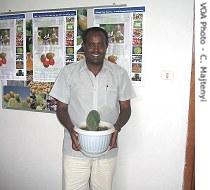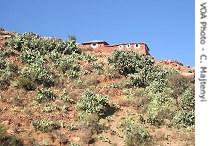Cactus Hailed as Viable Food Source in Northern Ethiopia

By Cathy Majtenyi Mekele,
Ethiopia 22 March 2006
The prickly pear cactus grows abundantly in many parts of northern Ethiopia's Tigray region. Sometimes known as a "hearty weed," the cactus is gaining new respect as a potential food source in an area plagued with inconsistent rainfall, environmental degradation, poor quality soils and other problems.
It is lunchtime at Yordanos Bright restaurant in downtown Mekele, the region's capital.
A few diners start tricking into the restaurant on Saturday afternoon to order dishes made of what would have been considered highly unpalatable about six months ago: the prickly pear cactus's broad, oval leaf, called nepolitos.
Today's menu includes nepolitos soup, nepolitos bread, cactus juice and nepolitos curry stew.
VOA language services stringer Girmay Gebru tastes cactus curry at Yordanos Bright restaurant in Tigray's regional capital Mekele
Diner Tsegazeab Gebrelibanos is eating the curry stew for the very first time.
"It's really wonderful," he says. "This is really nice and delicious. I'm going to be a regular diner here. I didn't think cactus would be food. Now I taste it. It's really nice. We should have used this before."
 The Saturday afternoon offerings at Yordanos restaurant is part of an initiative to get people to eat and use the whole prickly pear cactus plant, not just its fruit, which people have been consuming for decades.
The Saturday afternoon offerings at Yordanos restaurant is part of an initiative to get people to eat and use the whole prickly pear cactus plant, not just its fruit, which people have been consuming for decades.Although the last June to August rainy season was good, Tigray overall is considered to be a dry, water-stressed area. Soil fertility and moisture is generally low and wind and water erosion is a big problem.
Tesfay Alemseged, project manager at Swiss aid agency Helvetas Ethiopia, proudly displays cactus plant he keeps in his office
Tesfay Alemseged is manager of a cactus promotion project coordinated by the Swiss agency Helvetas Ethiopia. He says cactus is one of very few plants that can survive the harsh conditions found in parts of Tigray, making it a reliable, ready and highly nutritious food source. He says it even puts nutrients back into the soil.
"Cactus is highly tolerant. It can survive with even two or three years of mild or extremely low rainfall," explains Tesfay, "while the other plants dry up, and every stream dried up, the groundwater is going extremely down. So cactus is the only survivor in those areas. It can survive even on the roof of a house."
But convincing people to eat parts of the prickly pear cactus other than its fruit is another matter. Tesfay says Ethiopian cuisine has been around for centuries and most people are reluctant to try something new.
Cactus grows abundantly in many parts of northern Ethiopia's Tigray region, where officials are trying to convince people to include the highly nutritious plant in their diets.
To that end, Helvetas Ethiopia and its partners have embarked on a massive publicity campaign. Borrowing from cactus experiences in Mexico, the United States and other countries, they are trying to educate people on the nutritional value of the prickly pear cactus, how to cook it and the plant's other uses.
Last year, the organization held a week-long seminar for 150 elders, religious officials and other opinion leaders from villages all across Tigray. Seminar participants were shocked to discover that every dish served during the event was made with cactus.
Some 865 people to date have undergone five-day training sessions about the nutritional value of cactus and how to cook it. Each trainer, in turn, has committed to teaching at least 15 friends, neighbors and others in villages across Tigray how to prepare cactus dishes.
As well, about 130 urban restaurant owners in the region have been trained. Cooking demonstrations are also held in school clubs and cactus is prepared and served at religious ceremonies and traditional gatherings.
Tesfay says the campaign's results have been encouraging overall, with more and more people starting to accept cactus on their dinner plates.
He explains that food is not the only byproduct of the prickly pear cactus.
"It is a storehouse of virtues that have been commercially unexploited so far because of the lack of knowledge and technology," Tesfay says. "Different parts of the cactus can be used as fruit, as a vegetable for human consumption, as a fodder for cattle, as a raw material for various industries to prepare natural dyes, adhesives, and glues, products for treating blood sugar and various other disorders, and cosmetics also, like shampoo and cream, soap and body lotions."
The government plans to integrate cactus into its food security programs. The acting head of the Tigray Food Security Coordination Project office, Assefa Tewodros, says the government is in the process of offering cactus growing and production as one of the activities that low-income farmers can choose to increase their food security.
Assefa says that the prickly pear cactus has great potential for the program's low-income families, both as food and as a source of income.

"They are now involved in a variety of products from cactus: juice, marmalade, and even salad; they are preparing and selling," explains Assefa. "In some parts, they already started packing and selling the products of the cactus. It diversifies the income of these beneficiaries; they have also now familiarized the other people with the other products of the cactus. They are also using it as additional supplementary feed for their livestock."
He says households can make almost $350 a year from the sale of cactus products, a large amount of money among Ethiopia's farmers.
http://www.voanews.com/english/2006-03-22-voa17.cfm

0 Comments:
Post a Comment
<< Home